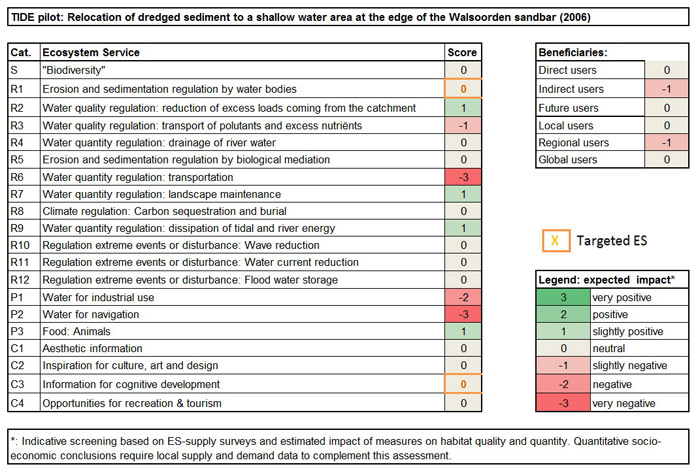

Disclaimer:
The authors are solely responsible for the content of this report. Material included herein does not represent the opinion of the European Community, and the European Community is not responsible for any use that might be made of it.
Back to overview measures
According to expert judgment, we do not have the possibility to indicate the relative involvement of different habitats in percentages and even less to indicate the quality. The reason for this is the fact that the in situ relocation test is just a small scale test to study the feasibility of the large scale relocation along a sandbar, and as such not a goal in itself.
Based on Figure 12, we can however qualitatively conclude that the area is elevated. Most of the area is still subtidal deep habitat, but also a very small area of subtidal moderately deep habitat was created at the sandbar side of the relocation area.
Step 2: Expected impact on ecosystem services, compared with targeted ecosystem services, and expected impact on beneficiaries
More information about the methodology and the correct interpretation of the results could be found in the overall measures report (Saathoff et al. 2013).
(1) Overall expected impact on ES:
From the ES assessment it is concluded that this measure generates both positive and negative expected impacts. A slightly positive expected impact is indicated for some regulating services Water quality regulation: reduction of excess loads coming from the catchment; water quantity regulation: landscape maintenance; and water quantity regulation: dissipation of tidal and river energy; as well as for the provisioning service Food: animals. A slightly to very negative expected impact is indicated for Water quality regulation: transport of pollutants and excess nutrients; Water quantity regulation: transportation; Water for industrial use; and Water for navigation.
The transformation from subtidal deep to subtidal shallow water is in general indeed negative for transportation. But in the local context of the relocation of dredged material at the edges of the Walsoorden sandbar it was proven that it contributes to the maintenance of the multiple channel system, which is positive for transportation.
(2) Expected impact on targeted ES
As this measure was only a test case, the target was limited to studying the stability of the relocated material (ES ‘Information for cognitive development’ and ‘Erosion and sedimentation regulation by water bodies’). The expected impact on both development targets is neutral.
(3) Expected impact on beneficiaries
The expected impact for the different beneficiary groups is slightly negative for indirect use and regional use. This is mainly the consequence of the negative expected impact for the transportation related ES, which could be questioned based on the local context of the measure.
Back to top
Walsoorden pilot part B (2006): relocation of dredged sediment to a shallow water area at the edge of the Walsoorden sandbar
Table of content
- 1. Description of measure
- 1a. Measure description
- 1b. Monitoring
- 1c. Monitoring results
- 2. Execution of main effectiveness criteria
- 2a. Effectiveness according to development targets of measure
- 2b. Impact on ecosystem services
- 2c. Degree of synergistic effects and conflicts according to uses
- 3. Additional evaluation criteria in view of EU environmental law
- 3a. Degree of synergistic effects and conflicts according to WFD aims
- 3b. Degree of synergistic effects and conflicts according to Natura 2000 aims
- 4. Crux of the matter
- 5. References
Additional information
for this measure:
No further information available.
for this measure:
No further information available.
Impact on ecosystem services
Step 1: Involved habitatsAccording to expert judgment, we do not have the possibility to indicate the relative involvement of different habitats in percentages and even less to indicate the quality. The reason for this is the fact that the in situ relocation test is just a small scale test to study the feasibility of the large scale relocation along a sandbar, and as such not a goal in itself.
Based on Figure 12, we can however qualitatively conclude that the area is elevated. Most of the area is still subtidal deep habitat, but also a very small area of subtidal moderately deep habitat was created at the sandbar side of the relocation area.
Step 2: Expected impact on ecosystem services, compared with targeted ecosystem services, and expected impact on beneficiaries
More information about the methodology and the correct interpretation of the results could be found in the overall measures report (Saathoff et al. 2013).
(1) Overall expected impact on ES:
From the ES assessment it is concluded that this measure generates both positive and negative expected impacts. A slightly positive expected impact is indicated for some regulating services Water quality regulation: reduction of excess loads coming from the catchment; water quantity regulation: landscape maintenance; and water quantity regulation: dissipation of tidal and river energy; as well as for the provisioning service Food: animals. A slightly to very negative expected impact is indicated for Water quality regulation: transport of pollutants and excess nutrients; Water quantity regulation: transportation; Water for industrial use; and Water for navigation.
The transformation from subtidal deep to subtidal shallow water is in general indeed negative for transportation. But in the local context of the relocation of dredged material at the edges of the Walsoorden sandbar it was proven that it contributes to the maintenance of the multiple channel system, which is positive for transportation.
(2) Expected impact on targeted ES
As this measure was only a test case, the target was limited to studying the stability of the relocated material (ES ‘Information for cognitive development’ and ‘Erosion and sedimentation regulation by water bodies’). The expected impact on both development targets is neutral.
(3) Expected impact on beneficiaries
The expected impact for the different beneficiary groups is slightly negative for indirect use and regional use. This is mainly the consequence of the negative expected impact for the transportation related ES, which could be questioned based on the local context of the measure.


